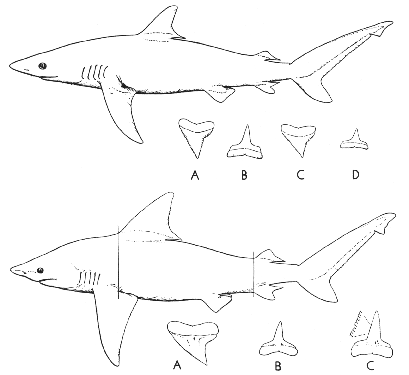Dusky shark Carcharhinus obscurus (LeSueur) 1818
[Bigelow and Schroeder, 1948, p. 382.]

Figure 14.—Above: Dusky shark (Carcharhinus obscurus), female about 39 inches long, Woods Hole. A, third upper tooth; B, fourth lower tooth; C, ninth upper tooth; D, tenth lower tooth; about 2.4 times natural size. Below: Brown shark (Carcharhinus milberti), female, about 4 feet 10 inches long, from Woods Hole. A, ninth upper tooth; B, eighth lower tooth; C, third lower tooth; about 1.4 times natural size. From Bigelow and Schroeder. Drawings by E. N. Fischer.
Description—
The combination of characters that place the dusky shark among the western Atlantic members of its genus are: Trunk about one-fifth as high at first dorsal fin as it is long to origin of the caudal fin, tapering both forward and rearward; snout broadly rounded in front, its length in front of the nostrils less than the distance between the nostrils; the front edge of the nostril is not expanded as a definite lobe; the midline of the back between the two dorsal fins has a low but definite ridge, a character which is very precise, though seemingly minor; the first dorsal fin is considerably smaller than in the brown shark [page 42] (p. 43), with more deeply concave rear margin, its point of origin about over the inner corner of the pectoral (over the armpit of the pectoral in the brown shark); its apex is narrowly rounded. The free rear corner of the second dorsal fin is less than twice as long as the vertical height of the fin. The anal fin is a little longer, along the base, than the second dorsal and stands about under the latter. The caudal fin occupies between one-quarter and one-third of the total length of the shark, the lower caudal lobe (measured along its anterior edge) is about two-fifths as long as the upper lobe; and the upper lobe is noticeably slender toward its tip. The pectorals are about as long (from origin to tip) as the distance from the tip of the snout to the level of the first pair of gill openings, usually narrower, relatively, than in the brown shark, and sometimes more definitely sickle-shaped.
The upper teeth are broadly triangular; nearly erect toward the center of the mouth but weakly oblique toward its corners; their inner margins are nearly straight, the outer margins increasingly concave outward along the jaw. The lower teeth are erect, symmetrical, with narrow cusp on a broadly expanded base. Both the upper teeth and the lower are serrate along the edges, the lower the more finely so.
Color—
All the fresh caught specimens we have seen have been bluish or leaden gray on the back [page 43] and upper part of the sides, including the pectorals, but this shark has also been described as pale gray above or even dirty white, perhaps over a white sand bottom. The trunk is white below, the pectorals grayish, darkening to sooty at their tips; the pelvics and anal fins grayish white.
Size—
The usual length at birth is a little more than three feet.[4] Adult dusky sharks so far measured have ranged from 10 feet 4 inches to 11 feet 8 inches in length, and they are said to grow to 14 feet, though perhaps not on very convincing evidence.
General range—
Western Atlantic, north to southern New England and to Georges Bank, south to southern Brazil, at least by name. A shark very closely allied to obscurus has been reported under that name in the eastern Atlantic, from Spain to Table Bay, South Africa, including Madeira, the Canaries, the Cape Verdes, Ascension Island, and St. Helena. But we have yet to learn its precise relationship to the obscurus of the western Atlantic.
Occurrence in the Gulf of Maine—
The dusky shark has been taken repeatedly off the coasts of New Jersey and of Long Island, N. Y.; also at Woods Hole, where we have handled 12 specimens during the past few summers, 6 of them in August 1944. But it so seldom strays to cooler waters farther east that only one shark has been recorded from Nantucket, and one from Georges Bank, that probably were of this species and not some other carcharhinid.[5] Thus it has no real place in the fauna of the Gulf.[6]
[4] Embryos have been reported up to 38 in. long (965 mm.), and a free living specimen of only 39 in. (993 mm.); see Bigelow and Schroeder, Fishes Western North Atlantic, Pt. 1, 1948, p. 387.
[5] Probably this species and not the brown shark because 11-12 feet long.
[6] In the first edition of this book, the dusky shark was said to have been taken at three localities within the Gulf. But one of these records, at least, was almost certainly based on a blue shark, and the others probably were (Bigelow and Schroeder, Fishes Western North Atlantic, Pt. 1, 1948, pp. 292, 368).